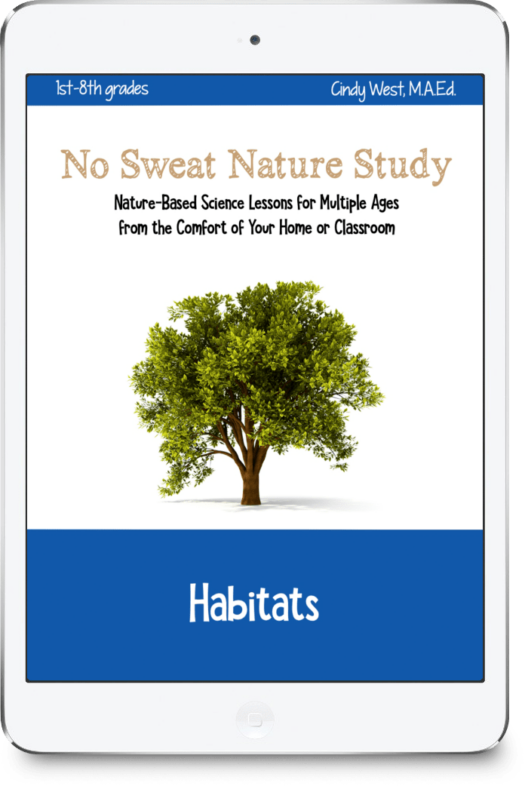Life Under Rocks Nature Study
I’m glad you’ve decided to join me for this episode of the No Sweat Nature Study Podcast! Today we’re going to visit a very unique habitat to see life under rocks!
Would you want to live under a rock? Besides the uncomfortable heaviness of a rock, it sure seems like it would be a damp, dark place to live, doesn’t it? I might consider living in a cave (which is a hole in a rock) if I really needed to for a short time, but actually living under a rock isn’t even a possibility.
Surprisingly, though, the underside of a rock can be quite the comfortable habitat for some life!

This post contains affiliate links.
What does the soil look like under a rock?
Have you ever lifted a rock before to peek underneath? What did you notice about the soil? Unless the weather was really dry, if you were observing clay or loam soil you probably noticed the soil was damp and cool. This is because a rock blocks the sun’s rays from the soil and there is, in turn, less evaporation. If you were observing sandy soil, you may not have noticed the soil as damp or cool because sandy soil drains water so fast.
Is there plant life under rocks?
What else did you see under the rock? Because rocks block the sun, plants don’t survive very well under there, so you probably saw a patch of brown soil in the same shape as the bottom of the rock. Every once in a while, you actually can find wimpy plants struggling to grow, but the darkness doesn’t make for a healthy growing situation for most plants.
On the other hand, sometimes you can find the mycelium of fungi when you lift a rock. A mycelium is a web of thread-like hyphae that are sort of like the roots of a fungus. Fungi aren’t plants, they are in their own special group. The fungi you are probably most familiar with are mushrooms. Did you know that the mushroom you see growing in the grass is only the fruiting body of a big network of these threads underground? It’s true! And, it’s not unusual to find some of the threads of the mycelium when you lift a rock.

Is there animal life under rocks?
Now, let’s think about animals. Have you noticed any animals living under rocks? Believe it or not, lots of animals like to live there!
I often find adult insects like ants, crickets, and beetles wandering around when I lift a rock. It’s not unusual to see the larvae of beetles under there, too. Do you happen to know what beetle larvae are called? Grubs! Grubs are the creamy white worm-looking things that are common to find in the soil. They aren’t worms at all though. They are in the worm-like 2nd stage of an insect’s life cycle called the larva stage. We’ve talked about insect life cycles before in the podcast episodes about pollinators and fireflies.
I bet you can think of another squirmy animal that’s often wriggling around underneath a rock. Yes, soil-loving earthworms are easy to see there most of the time.
I know that lots of people are afraid of spiders, but most species are completely harmless. You should certainly know which ones live in your area are dangerous, but there’s usually no need to be afraid. I tell you this because sometimes spiders live under rocks, too.
Have you seen the sparkly, slimy trail of a snail or slug under a rock before? These interesting creatures travel on a single foot across self-made mucus and the ones that live on land like to live under rocks, too.

How do these all animals live under a rock?
They are tiny enough to live in the spaces between the rock and the soil or they hang out in the soil around the surface.
I’m sure you know that you aren’t likely to find any larger animals living under rocks. At least the relatively small rocks that you’re able to lift for an underneath peek. But some larger animals like snakes, ermines, some ground birds, and even larger animals do live under larger rocks that have decent-sized crevices between the rock and the ground.
Nature Walk Curriculum
-
No Sweat Nature Study MembershipFrom: $25.00 / month
-
Product on sale40 Nature Walks: Volume 1$15.00
-
Product on saleCreative Nature Walks$15.00
Life Under Rocks Nature Walk Challenge
For today’s nature walk challenge, all you need is your nature journal and colored pencils. If you have a magnifying glass, free free to grab it, too.
Take a nature walk where you will be able to find rocks – and where you will have permission to lift the rocks for a quick peek underneath. My favorite places to do this are near the edges of shallow creeks or ponds or woodland trails. You will likely be able to find rocks in your yard, in an empty lot, or at the local park, too.
Your job is to carefully lift one side of a rock to take a peek underneath in order to look for signs of life. When you see something living – like a dwindling plant, fungi mycelium, insects, spiders, or other animals – draw and label them in your nature journal.
If you want to be really fancy, make eight boxes on your nature journal page and label the boxes with the following titles: plants, fungi, insects, spiders, worms, gastropods (those are snails and slugs), and others. As you find specimens under a rock, draw the plants, fungi, or animals in whichever box matches the specimen. (You’ll have one box left over. Feel free to do whatever you want in that box. It might be nice to add a colorful title to your page!)

Protect the habitat under a rock!
It’s very important to carefully lift just one side of a rock and then place it gently back exactly as it was. You see, when you lift a rock, you’re disturbing the habitat. That means you’re disturbing someone’s home. In order to keep the flora and fauna of the habitat alive after you leave, it’s very important that you put the rock back in its proper place.
By the way, can you guess what flora and fauna mean? Flora (which sounds kind of like the word flower) means plant life. Fauna (which sounds kind of like the word fawn – a baby deer) means animal life.
Feel free to take a peek under as many rocks as you can find to see as many specimens of living things underneath them as possible.
Until next time when we learn about delightful hummingbirds…happy nature exploring!
Links and Resources
Please leave a rating or a review on your podcast app! It helps the podcast to show up for more people…which means more families can enjoy science through the wonderful lens of nature study! Thank you!
Would you like to record a voicemail to answer this season’s nature study question?
At the end of each No Sweat Nature Study Podcast episode, Mrs. Cindy includes messages from a few of her friends. You have the opportunity to record a message that she might use on an upcoming episode!
All children must have their parents’ permission before leaving a recording. Parents are welcome to record an answer, too!
Each season, there will be a different question to answer. You can see this season’s question below. Think about your answer first and then follow these simple directions:
- Click the button that says “start recording”.
- Tell me your first name. (If you want to tell your age and/or where you live, feel free to do that, too.)
- You will have 60 seconds to answer the question, but try to be concise.
- Push the play button to listen to your recording before sending it to be sure it is recorded properly. If not, simply record it again.
















